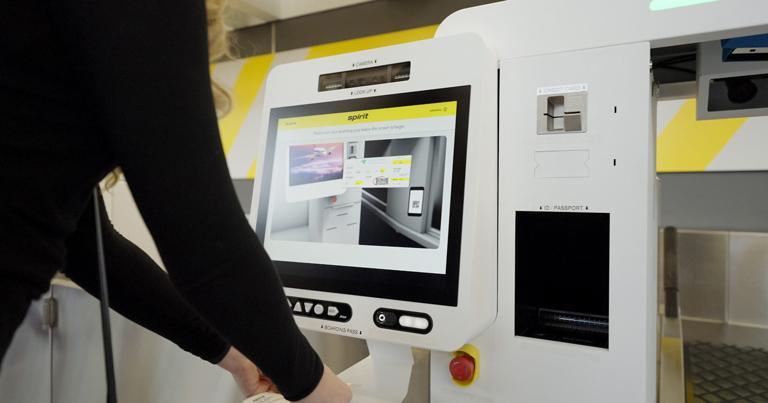
Spirit Airlines’ automated self-bag drop system with biometric photo-matching technology is now live at Hartsfield-Jackson Atlanta International Airport (ATL).
The self-bag drop system allows passengers to check their bags directly without working with an agent. The system is equipped with a biometric photo-matching technology that compares a scan of government-issued identification with a photo of the passenger for verification. Following an initial testing period at ATL with both manual ID check and biometric opt-in, the solution will eliminate the need to hand government-issued identification to an agent when checking baggage.
Spirit developed the nation’s first biometric photo-matching solution for domestic air travel in 2019 with its partner Materna Intelligent Passenger Solutions (IPS) North America, and it has since been deployed at New York’s LaGuardia Airport (LGA), Chicago O’Hare (ORD) and Dallas Fort Worth (DFW).
“We’re on a mission to find innovative opportunities to continue improving every facet of the Guest experience, to include this investment in self-service so Guests spend less time in lobbies,” said Mike Byrom, Vice President of Airport Services for Spirit Airlines. “Our Guests are tech-savvy, and they appreciate options for controlling their travel journey. Another reason why the technology is advantageous for Guests is because it complements our staffing and helps preserve consistency of service.”
“Hartsfield-Jackson prides itself on its efficiency and safety,” said ATL general manager Balram Bheodari. “Through advances in innovation, this project is designed to increase both, and we welcome such efforts.”
Spirit Guests currently check an annual daily average of about 1,000 bags at ATL, and each of which represents a face-to-face interaction that can be streamlined. Testing data shows the new procedure drops average processing time to just 70 seconds per passenger, reducing time spent at bag check by 30%. Additionally, passengers can take advantage of the time savings and reduction in interactions whether they’re travelling domestically or internationally.
The self-bag drop system uses software capable of analysing key physical features on more than 50,000 forms of ID from nearly 200 countries that a passenger could potentially use when travelling in the United States. Combined with the units’ scanning hardware, the software confirms the authenticity of an ID and rejects fraudulent documents as the customer checks their baggage.
Here’s how the biometric photo-matching works:
- Passengers tag their own checked bags after checking in at the kiosk and then proceed to the self-bag drops
- Passengers are advised of the biometric option after scanning their boarding pass at the self-bag drop unit. They may either opt in and continue unassisted or opt out for agent-assisted service.
- Once the passenger opts in, the unit instructs them to scan their ID on the built-in hardware.
- The unit compares its scan of the photo on the ID with a facial scan captured by its on-board sensors, along with comparing identification information with the passenger’s reservation details. Spirit says that it doesn’t share any data with government agencies or other parties.
- A successful match initiates the rest of the automated bag check-in process. Passengers are instructed to place their bags on the conveyor belt attached to the unit, which then scans the bags, weighs them, accepts payment for any additional optional services, and sends them straight into their airport’s checked baggage system without any further action from the passenger.







